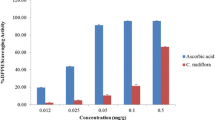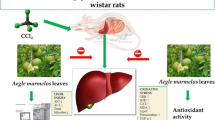Abstract
The present study was undertaken to investigate whether or not the hepatoprotective activity of acetylbergenin was superior to bergenin in carbon tetrachloride (CCl4)-intoxicated rat. Acetylbergenin was synthesized by acetylating bergenin, which was isolated frommallotus japonicus. The hepatoprotective effects of acetylbergenin were examined against CCl4-induced liver damage in rats by means of serum and liver biochemical indices. Acetylbergenin was administered orally once daily for 7 successive days, then a 0.5 ml/kg mixture of CCl4 in olive oil (1∶1) was intraperitoneally injected at 12 h and 36 h after the final administration of acetylbergenin. Pretreatment with acetylbergenin reduced the elevated serum enzymatic activities of alanine/aspartate aminotransferase, sorbitol dehydrogenase and γ-glutamyltransferase in a dose dependent fashion. Acetylbergenin also prevented the elevation of hepatic malondialdehyde formation and depletion of glutathione content dose dependently in CCl4-intoxicated rats. In addition, the decreased activities of glutathione S-transferase and glutathione reductase were restored to almost normal levels. The results of this study strongly suggest that acetylbergenin has potent hepatoprotective activity against CCl4-induced hepatic damage in rats by glutathione-mediated detoxification as well as having free radical scavenging activity. In addition, acetylbergenin doses of 50 mg/kg showed almost the same levels of hepatoprotective activity as 100 mg/kg of bergenin, indicating that lipophilic acetylbergenin is more active against the antihepatotoxic effects of CCl4 than those of the much less lipophilic bergenin.
Similar content being viewed by others
References
Azri, S., Mata, H. P., Reid, L. L., Gandlofi, A. J., and Brendel, K., Further examination of the selective toxicity of CCl4 rat liver slices.Toxicol. Appl. Pharmacol., 112, 81–86 (1992).
Boyer, T. D., Vessey, D. A., Holcomb, C., and Saley, N., Studies of the relationship between the catalytic activity and binding of non-substrate ligands by the glutathione S-transferases.Biochem. J., 217, 179–185 (1984).
De Groot, H. and Noll, T., The crucial role of low steady state oxygen partial pressures in haloalkane free-radical-mediated lipid peroxidation.Biochem. Pharmacol., 35, 15–19 (1986).
Ellman, G. L., Tissue sulfhydryl group.Arch. Biochem. Biophys., 82, 70–77 (1959).
Gerlach, U., Sorbitol dehydrogenase, In Bergmeyer, H. U. (Ed.).Method in Enzymology. Elsevier, New York, 761–767 (1965).
Gravela, E., Albano, E., Dianzani, M. U., Poli, G., and Slater, T. F., Effects of carbon tetrachloride on isolated rat hepatocytes. Inhibition of protein and lipoprotein secretion.Biochem. J., 178, 509–512 (1979).
Habig, W. H., Pabst, M. J., and Jakoby, W. B., Glutathione S-transferases: the first enzymatic step in mercapturic acid formation.J. Biol. Chem., 249, 7130–7139 (1974).
Hikino, H., Kiso, Y., Hatano, T., Yoshida, T., and Okuda, T., Antihepatotoxic actions of tannins.J. Ethnopharmacol., 14, 19–29 (1985).
Kim, H. S., Lim, H. K., Chung, M. W., and Kim, Y. C., Antihepatotoxic activity of bergenin, the major constituent ofMallotus japonicus, on carbon tetrachloride-intoxicated hepatocytes.J. Ethnopharmacol., 69, 79–83 (2000a).
Kim, H. S., Lim, H. K., Lee, K. S., Chung, M. W., Jang, C. G., and Oh, S., Hepatoprotective effects of bergenin derivatives against intoxication of rat hepatocytes by carbon tetrachloride and D-galactosamine.J. Ethnopharmacol., submitted (2000b).
Lim, H. K., Kim, H. S., Choi, H. S., and Choi, J. W., Protective and therapeutic effects of Malloti Cortex extract on carbon tetrachloride- and galactosamine-induced hepatotoxicity in rats.J. Appl. Pharmacol., 7, 35–43 (1999).
Lim, H. K., Kim, H. S., Chung, M. W., and Kim, Y. C., Protective effects of bergenin, the major constituent ofMallotus japonicus, on D-galactosamine-intoxicated rat hepatocytes.J. Ethnopharmacol., 70, 69–72 (2000).
Lowry, O. H., Rosebrough, N. J., Farr, A. L., and Randall, R. J., Protein measurement with the folin phenol reagent.J. Biol. Chem., 193, 265–275 (1951).
Masukawa, T. and Iwata, H., Possible regulation mechanism of microsomal glutathione S-transferase activity in rat liver.Biochem. Pharmacol., 35, 435–438 (1986).
Mitchell, J. R., Jollow, D. J., Potter, W. Z., Gillette, J. R., and Brodie, B. B., Acetaminophen induced hepatic necrosis. IV. Protective role of glutathione.J. Pharmacol. Exp. Ther., 187, 211–217 (1973).
Miyagawa, C., Wu, C., Kennedy, D. O., Nakatani, T., Ohtani, K., Sakanaka, S., Kim, M., and Matsui-Yuasa, I., Protective effect of green tea extract and tea polyphenols against the cytotoxicity of 1,4-naphthoquinone in isolated rat hepatocytes.Biosci. Biotechnol. Biochem., 61, 1901–1905 (1997).
Mize, C. E. and Langdon, R. G., Hepatic glutathione reductase: I. Purification and general kinetic properties.J. Biol. Chem., 237, 1589–1595 (1962).
Ohkawa, H., Ohishi, N., and Yagi, K., Assay for lipid peroxides in animal tissues by thiobarbituric acid reaction.Anal. Biochem., 95, 351–358 (1979).
Park, J. C. and Choi, J. W., Effects of methaol extract of oenanthe javanica on the hepatic alcohol-metabolizing enzymed system and its bioactive component.Phytother. Res., 11, 260–262 (1997).
Park, J. C., Yu, Y. B., Lee, J. H., Hattori, M., Lee, C. K., and Choi, J. W., Protective effect of Oenanthe javanica on the hepatic lipid peroxidation in bromobenzene-treated rats and its bioactive component.Planta Med., 62, 488–490 (1996).
Ramaiah, P. A., Row, L. R., Reddy, D. S., Anjaneyulu, A. S. R., Ward, R. S., and Pelter, A., Isolation and characterization of bergenin derivatives fromMacaranga peltata.J. Chem. Soc., 2313–2316 (1979).
Recknagel, R. O. and Glende, E. A. Jr., Carbon tetrachloride hepatotoxicity: an example of lethal cleavage.CRC Crit. Rev. Toxicol., 2, 263–297 (1973).
Recknagel, R. O. and Glende, E. A. Jr., Lipid peroxidation: a specific from of cellular injury, In Lee, D. H. K., Falk, H. L., Murphy, S. D., and Geiger, S. R. (Eds.).Handbook of physiology, section 9: Reactions to environmental agents. Williams & Wilkins, Baltimore, pp. 591–601 (1977).
Recknagel, R. O., Glende, E. A. Jr., and Britton, R. S., Free radical damage and lipid peroxidation, In Meeks, R. G., Harrison, S. D. and Bull, R. J. (Eds.).Hepatotoxicology, CRC Press, Florida, pp 401–436, (1991).
Recknagel, R. O., Glende, E. A. Jr., Ugazio, G., Koch, R. R., and Serinvasan, S., New data in support of the lipid peroxidation theory of carbon tetrachloride liver injury.Israeli J. Med. Sci., 10, 301–307 (1974).
Reed, D. R., Basson, J. R., Beatty, P. W., Brodie, A. E., Ellis, W. W., and Potter, D. W., High performance liquid chromatography of nanomoles of levels of glutathione, glutathione disulfide, and related thiols and disulfides.Anal. Biochem., 106, 55–62 (1980).
Reiner, O., Athanassopoulos, S., Hellmer, K. H., Murray, R. E., and Uehleke, H., Formation of chloroform from carbon tetrachloride in liver microsomes, lipid peroxidation and destruction of cytochrome P-450.Arch. Toxicol., 29, 219–233 (1972).
Reitman, S. and Frankel, S., A colorimetric method for the determination of serum glutamic oxaloacetic and glutamic pyruvic transaminases.Am. J. Clin. Pathol., 28, 56–63 (1957).
Szasz, G., A kinetic photometric method for serum γ-glutamyl-transpeptidase.Clin. Chem., 15, 124–136 (1969).
Tallarida, R. J. and Murray, R. B.,Manual of Pharmacologic Calculations with Computer Programs.Ed2., Springer-Verlag, New York, 1986.
Wolf, C. R., Harrelson, W. G. Jr., Nastainczyk, W. M., Philpot, R. M., Kalyanaraman, B., and Mason, R. P., Metabolism of carbon tetrachloride in hepatic microsomes and reconstituted monooxygenase systems and its relationship to lipid peroxidation.Mol. Pharmacol., 18, 553–558 (1980).
Author information
Authors and Affiliations
Corresponding author
Rights and permissions
About this article
Cite this article
Lim, HK., Kim, HS., Kim, SH. et al. Protective effects of acetylbergenin against carbon tetrachloride-induced hepatotoxicity in rats. Arch. Pharm. Res. 24, 114–118 (2001). https://doi.org/10.1007/BF02976478
Received:
Issue Date:
DOI: https://doi.org/10.1007/BF02976478




